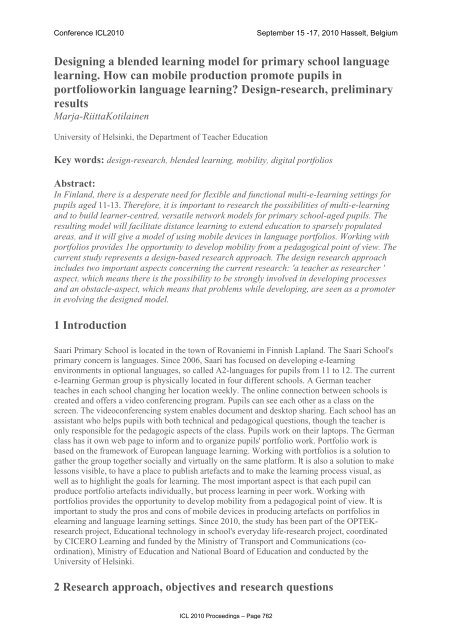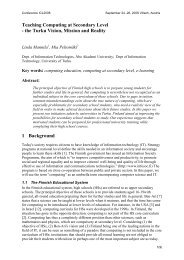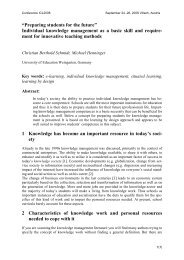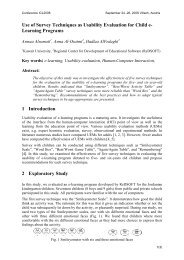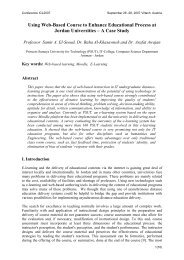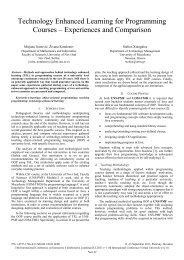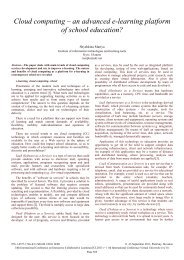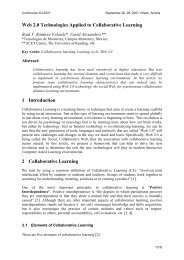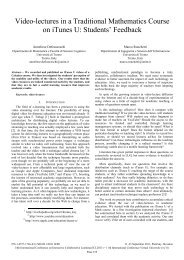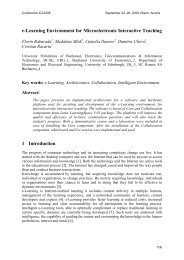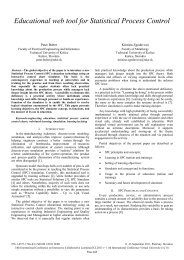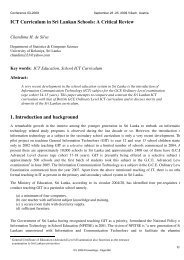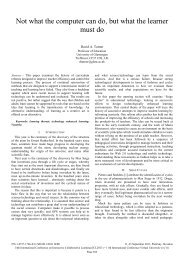Designing a blended learning model for primary school ... - ICL
Designing a blended learning model for primary school ... - ICL
Designing a blended learning model for primary school ... - ICL
Create successful ePaper yourself
Turn your PDF publications into a flip-book with our unique Google optimized e-Paper software.
Conference <strong>ICL</strong>2010September 15 -17, 2010 Hasselt, Belgium<strong>Designing</strong> a <strong>blended</strong> <strong>learning</strong> <strong>model</strong> <strong>for</strong> <strong>primary</strong> <strong>school</strong> language<strong>learning</strong>. How can mobile production promote pupils inportfolioworkin language <strong>learning</strong>? Design-research, preliminaryresultsMarja-RiittaKotilainenUniversity of Helsinki, the Department of Teacher EducationKey words: design-research, <strong>blended</strong> <strong>learning</strong>, mobility, digital portfoliosAbstract:In Finland, there is a desperate need <strong>for</strong> flexible and functional multi-e-Iearning settings <strong>for</strong>pupils aged 11-13. There<strong>for</strong>e, it is important to research the possibilities of multi-e-<strong>learning</strong>and to build learner-centred, versatile network <strong>model</strong>s <strong>for</strong> <strong>primary</strong> <strong>school</strong>-aged pupils. Theresulting <strong>model</strong> will facilitate distance <strong>learning</strong> to extend education to sparsely populatedareas, and it will give a <strong>model</strong> of using mobile devices in language portfolios. Working withportfolios provides 1he opportunity to develop mobility from a pedagogical point of view. Thecurrent study represents a design-based research approach. The design research approachincludes two important aspects concerning the current research: 'a teacher as researcher 'aspect, which means there is the possibility to be strongly involved in developing processesand an obstacle-aspect, which means that problems while developing, are seen as a promoterin evolving the designed <strong>model</strong>.1 IntroductionSaari Primary School is located in the town of Rovaniemi in Finnish Lapland. The Saari School's<strong>primary</strong> concern is languages. Since 2006, Saari has focused on developing e-Iearningenvironments in optional languages, so called A2-languages <strong>for</strong> pupils from 11 to 12. The currente-Iearning German group is physically located in four different <strong>school</strong>s. A German teacherteaches in each <strong>school</strong> changing her location weekly. The online connection between <strong>school</strong>s iscreated and offers a video conferencing program. Pupils can see each other as a class on thescreen. The videoconferencing system enables document and desktop sharing. Each <strong>school</strong> has anassistant who helps pupils with both technical and pedagogical questions, though the teacher isonly responsible <strong>for</strong> the pedagogic aspects of the class. Pupils work on their laptops. The Germanclass has it own web page to in<strong>for</strong>m and to organize pupils' portfolio work. Portfolio work isbased on the framework of European language <strong>learning</strong>. Working with portfolios is a solution togather the group together socially and virtually on the same plat<strong>for</strong>m. It is also a solution to makelessons visible, to have a place to publish artefacts and to make the <strong>learning</strong> process visual, aswell as to highlight the goals <strong>for</strong> <strong>learning</strong>. The most important aspect is that each pupil canproduce portfolio artefacts individually, but process <strong>learning</strong> in peer work. Working withportfolios provides the opportunity to develop mobility from a pedagogical point of view. It isimportant to study the pros and cons of mobile devices in producing artefacts on portfolios ine<strong>learning</strong> and language <strong>learning</strong> settings. Since 2010, the study has been part of the OPTEKresearchproject, Educational technology in <strong>school</strong>'s everyday life-research project, coordinatedby CICERO Learning and funded by the Ministry of Transport and Communications (coordination),Ministry of Education and National Board of Education and conducted by theUniversity of Helsinki.2 Research approach, objectives and research questions<strong>ICL</strong> 2010 Proceedings – Page 762
Conference <strong>ICL</strong>2010September 15 -17, 2010 Hasselt, BelgiumThe current study represents a design-based research approach, which is meant to be any kindof research that produces findings that are modified back into further cycles of innovativedesign (Bereiter, 2002). A practical design-problem in this study is to develop a <strong>blended</strong><strong>learning</strong> <strong>model</strong> <strong>for</strong> <strong>primary</strong> <strong>school</strong> language <strong>learning</strong>. A theoretical problem is to researchhow mobile production can support and promote pupils in portfolio-work in language<strong>learning</strong>. The research question is to investigate what should a <strong>blended</strong> <strong>learning</strong> <strong>model</strong> consistof to promote pupils' autonomy and in producing content <strong>for</strong> portfolios in language <strong>learning</strong>?The more specific objectives of the study are:1. of what should a <strong>blended</strong> <strong>learning</strong> <strong>model</strong>consist in language <strong>learning</strong>? 2. How does portfolio work promote pupils' autonomy? 3. Howdo the elements of mobility corne true in blvnded <strong>learning</strong> settings? Pedagogical frameworkconsists of approaches and theories, which are considered according to the phase of the study:<strong>blended</strong> <strong>learning</strong> in phases 1-2 (Adams, 2009), digital language portfolios in phase 3 (Barret,2010), and mobility in phase 4 (Kynaslahti, 2003).3 Some preliminary resultsThe preliminary result of this design-research indicates that <strong>primary</strong> <strong>school</strong>-aged pupils dohave the capacity <strong>for</strong> independent work on the network temporarily, but a teacher's presencevirtually or physically is important. As a consequence of this finding, the next modification ofthe <strong>blended</strong> language <strong>learning</strong> <strong>model</strong> consisted of many usual classroom practices andelements. The most important was to combine separate e-Iearning groups to one German classprojecting them virtually on the screen. Group cohesion is very important in terms ofmotivation and <strong>learning</strong> outcomes. Pupils were satisfied with the present portfolio <strong>model</strong>.According to them, the positives of portfolios was being able to work individually, to workfreely, to produce unique personal artefacts,and to be able to make their own decisions whileworking. Pupils' attitudes to language <strong>learning</strong> with laptops after <strong>school</strong> lessons were positive:"It made me really work".References:Adams, J. 2009: Blended Learning Strategies <strong>for</strong> Promoting Workplace Learning & Per<strong>for</strong>mance Improvement. - URL(referred 12.5.2010):Barret, H. 2010: Portfolio Life. ePortfolios <strong>for</strong> Faculty Professional Development and Lifelong Learning. - URL(referred 12.5.2010):Bereiter, C. 2002: Design Research <strong>for</strong> Sustained Innovation. URL (referred 26.4.2010)Kynaslahti, H.2003: In Search of Elements of Mobility in the Context of Education. In Mobile Learning, edited byKynaslahti H.& Seppala P. IT PressAuthor:Marja-Riitta. Kotilainen, project researcher, language teacherUniversity of Helsinki, the Department of Teacher EducationPohjatuulentie 6, 96900 Rovaniemi, Finlandmarja-riitta.kotilainen@helsinki.fi<strong>ICL</strong> 2010 Proceedings – Page 763


